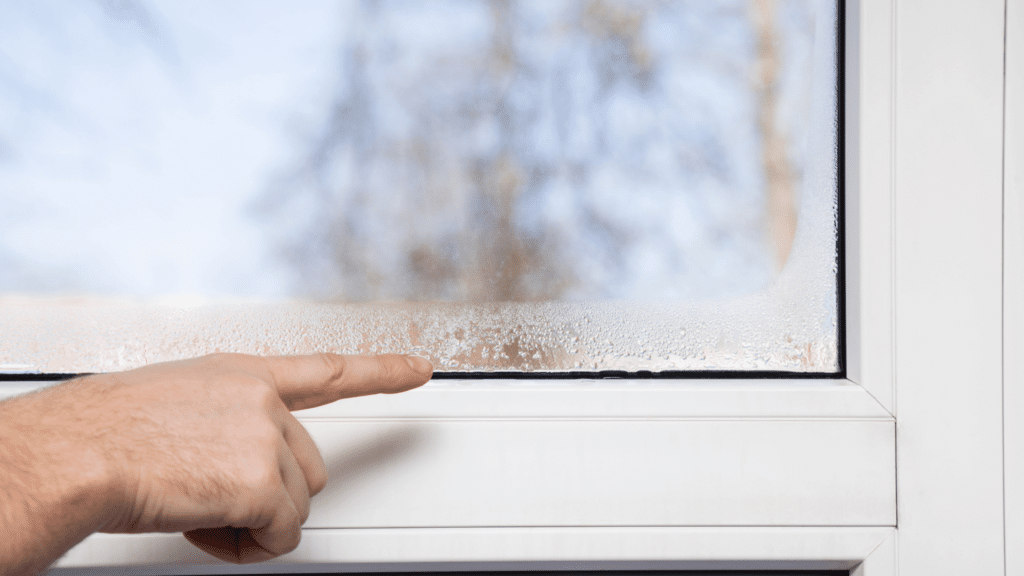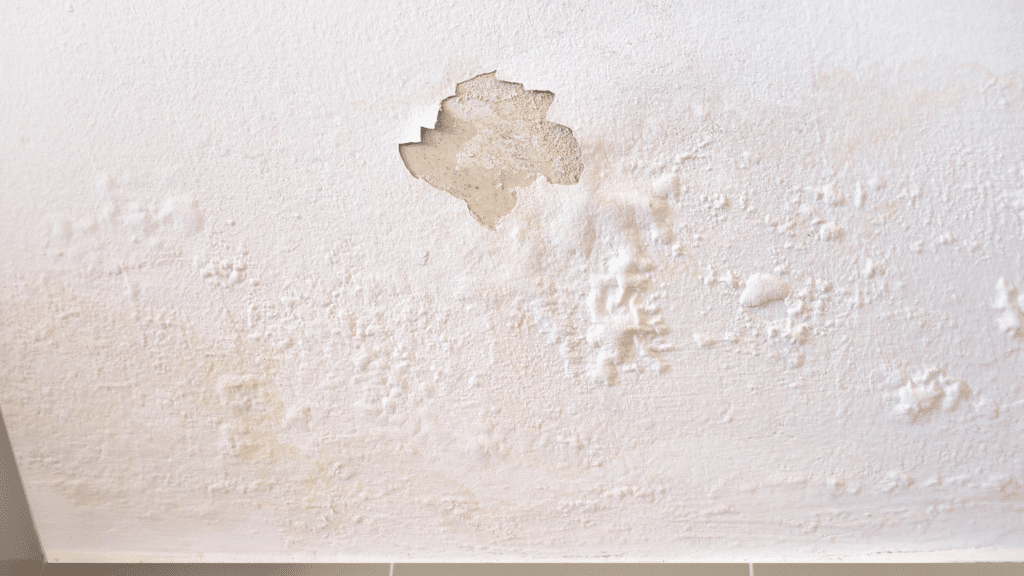Opting for a heat pump vs a gas furnace can offer various advantages, considering that…
Cracking the Code: Why Your House Feels Humid
Your house feels humid due to several factors, from faulty appliances to inadequate ventilation. We’ll dive into the common causes and help you identify the source of the problem.
As winter blankets the surroundings with its chill, humidity becomes a subtle force that influences more than cold temperatures. While the biting cold may be the primary concern during winter, understanding and managing humidity can transform your indoor environment. In this comprehensive guide, discover the often-overlooked impact of moisture in winter and unlock the secrets to creating a comfortably balanced home.
Have you ever walked into your home only to be greeted by that unmistakable feeling of excess humidity? If the answer is yes, you’re not alone. High humidity levels make your home uncomfortable and can lead to various issues like mold growth and musty odors. We’re here to crack the code on why your house feels humid and introduce a game-changing solution: the whole home humidifier.
Jackson, TN, with its diverse climate, often experiences high humidity levels that can significantly impact the comfort and well-being of residents. In this comprehensive guide, we’ll delve into the hidden effects of humidity on your home and provide practical tips for managing and optimizing indoor humidity levels.
Understanding the Hidden Impact of Humidity on Your Home

High humidity can be a pervasive issue, leading to discomfort, health concerns, and potential damage to your home. From the sticky feeling in the air to the musty odors that can develop, the impact of humidity is often underestimated. In this section, we’ll explore the various ways in which humidity affects your living space.
Understanding the root cause of high humidity is the first step toward creating a more comfortable living space. Factors like inadequate ventilation, air leaks, and regional climate variations can affect elevated humidity levels. But worry not, as we unveil a powerful tool that can transform your indoor environment – the whole home humidifier.
- What is Humidity?
- Recognizing the Signs of High Humidity in Your Home
- Problems caused by high humidity
- Humidity and Heating Systems
- Does Heat Lower Humidity?
- The Benefits of Whole Home Humidifiers
- Installation and Operation Made Easy
- Choosing the Right Whole Home Humidifier for Your Needs
What is Humidity?
Humidity is like a measure of moisture in the air. When we talk about “relative humidity,” it’s about how much moisture the air can hold compared to the maximum it can hold at its current temperature. When warmer, the air can hold more moisture, making those summer days feel sticky. Interestingly, air conditioners were first created not to keep us cool but to keep paper dry. So, managing humidity is not just about comfort but also has surprising historical roots!
Recognizing the Signs of High Humidity in Your Home

Home humidity impacts various aspects, including temperature, indoor air quality, health, and the structure of your house.
Temperature is influenced by humidity, as humid air holds heat better than dry air. Maintaining an optimal humidity level during winter can make your home cozier, reducing the need for constant heating. Some homes use humidifiers and dehumidifiers to keep humidity in check.
Balanced humidity is essential for indoor air quality. When the air is too dry, dust circulates more quickly, skin flakes, and fixtures become overly dry. This can lead to lung and throat irritation. Conversely, high humidity can foster mold and bacterial growth, triggering allergies and causing damage to wooden fixtures and drywall.
Even if you don’t see mold, persistent high humidity can contribute to hidden issues like mold growth and rot. So, managing home humidity is not just about comfort – it’s about creating a healthy and structurally sound living environment.
Problems caused by high humidity

- Mold and Mildew Hazards: Mold and mildew find their haven in humid conditions, leading to unsightly and potentially harmful growth on walls, ceilings, and furniture. These fungi pose health risks, especially for individuals with allergies, asthma, or compromised immune systems.
- Pest Invasion Alert: High humidity is a magnet for pests such as cockroaches, dust mites, and rodents. These unwelcome visitors damage property and pose a health risk by carrying and spreading diseases.
- Structural Integrity at Risk: Excessive moisture can wreak havoc on wood, causing it to warp, rot, or swell and leading to substantial repair costs. Additionally, high humidity negatively affects your home’s insulation, resulting in poor energy efficiency and inflated utility bills.
- Condensation: Humidity fosters the formation of condensation on windows and cold surfaces, paving the way for water damage and dampness. Over time, this can diminish your home’s value and create an uncomfortable living environment.
Humidity and Heating Systems
One often overlooked aspect is the connection between humidity and heating systems. We’ll explore how heating systems can influence indoor humidity levels, providing insights into why your house humidity may be higher during certain seasons or conditions.
Unlike portable humidifiers that only address specific rooms, a whole home humidifier ensures consistent humidity control across all living spaces. This comprehensive solution is particularly beneficial for larger homes or those with open floor plans.
Does Heat Lower Humidity?
It’s a widespread belief that high temperatures automatically lead to lower humidity, but let’s dispel this common myth and delve into the intricate relationship between heat and moisture. Understanding this dynamic is crucial for homeowners creating a balanced indoor environment.
The Heat and Humidity Connection
Contrary to popular belief, an increase in temperature doesn’t necessarily translate to lower humidity levels. The connection between heat and humidity is more nuanced than a straightforward cause-and-effect relationship. Warm air can hold more moisture, potentially leading to elevated humidity. To optimize your indoor environment, it’s essential to grasp this interplay and debunk the misconception that heat alone is a reliable humidity reducer.
Valuable Insights for Homeowners: Navigating the Temperature-Humidity Landscape
To navigate the temperature-humidity landscape effectively, homeowners need to consider various factors. Here are critical insights that shed light on this intricate relationship:
- Temperature’s Influence on Moisture Capacity: Warmer air can hold more moisture, contributing to higher humidity levels.
- Optimizing Indoor Comfort: Balancing temperature and humidity is crucial for creating a comfortable living space.
- Preventing Excess Humidity: While heat alone may not lower humidity, implementing strategies to manage humidity becomes essential to avoid issues like mold growth and discomfort.
Creating an Ideal Indoor Environment: Strategies for Humidity Control
Debunking the myth that heat automatically lowers humidity opens the door to effective strategies for maintaining an ideal indoor environment. Consider these actionable steps:
- Utilize Dehumidifiers: Integrate dehumidifiers into your living spaces to extract excess moisture.
- Ventilate Properly: Ensure proper ventilation to allow fresh air circulation and control humidity.
- Monitor and Adjust: Invest in humidity monitoring tools and adjust your home’s settings to achieve a harmonious balance.
The Benefits of Whole Home Humidifiers
 Gas furnaces generate heat directly, while heat pumps transfer heat. Gas furnaces are more effective in colder regions, providing warmer heat unaffected by outdoor temperatures.
Gas furnaces generate heat directly, while heat pumps transfer heat. Gas furnaces are more effective in colder regions, providing warmer heat unaffected by outdoor temperatures.
Heat pumps face challenges in transferring heat when temperatures drop below freezing. Supplementary heating systems can compensate, but they are energy-intensive and costly. Heat pumps are preferable in temperate regions where gas furnace heat might be hot. Furnaces, however, produce dry air that can lead to skin dryness, while heat pumps circulate naturally humid air. Heat pumps also offer the advantage of providing cooling in the summer.
Operational noise differs, with heat pumps generally being noisier than furnaces. The compressor and air handler produce regular clicking and knocking sounds in heat pumps. At the same time, furnaces typically emit a whooshing sound during initial burner ignition, often going unnoticed due to their placement in basements or away from living areas.
Your HVAC system plays a crucial role in maintaining optimal humidity levels. Learn how to leverage your heating, ventilation, and air conditioning system to effectively control humidity in your home, ensuring a comfortable living environment year-round.
Installation and Operation Made Easy
Are installation worries on your mind? We install whole-home humidifiers for seamless integration into your current HVAC system, or we can start from scratch. Our expert installation guarantees efficient system operation, offering hassle-free humidity control with a simple touch of a button.
Choosing the Right Whole Home Humidifier for Your Needs
With various models on the market, choosing a whole home humidifier that suits your needs is essential. Consider factors such as the size of your home, the level of automation you desire, and additional features that enhance user experience.
1. Home Size Matters: Matching Capacity to Your Space
Begin by assessing the size of your home, as it plays a pivotal role in determining the humidifier’s capacity required. Larger homes may benefit from high-capacity models, ensuring consistent humidity distribution across spacious living areas. Conversely, smaller homes may find a more moderate-capacity humidifier to meet their needs without overpowering the space.
2. Automation Preferences
Explore the level of automation that aligns with your preferences and lifestyle. Some whole-home humidifiers have advanced features such as innovative technology and programmable settings. These options allow for seamless integration with your home’s existing systems and provide the convenience of remote control or automated adjustments based on specific humidity levels.
3. Additional Features
Look beyond basic functionalities and consider additional features to enhance your overall user experience. Some humidifiers offer features like multiple speed settings, customizable humidity controls, and easy maintenance mechanisms. These elements contribute to optimal performance and ensure the humidifier seamlessly integrates into your daily life. Explore Your Options with Tim Ferguson Plumbing; call us today to schedule an appointment.
We Tackle High Humidity Issues for Jackson Homes
To sum up, if you’ve ever asked yourself, why is my house always humid? Discover the solution with Whole-House Dehumidifiers. Get optimal humidity levels in your home and address the issues associated with high humidity. These dehumidifiers diligently eliminate excess moisture, protecting your home from mold, mildew, pests, structural damage, and dampness.
Ready to take control of your home’s humidity? Connect with Tim Ferguson Plumbing. Today, discover personalized strategies to enhance your living environment in the Jackson area. Our knowledgeable team is here to guide you through the selection process, ensuring that the whole-home humidifier you choose becomes a seamless and practical addition to your home. Call us now to discover how to enhance indoor comfort through optimal humidity control.

Contact us today, and take the first step towards coziness by calling us today! Our expert team guides you whether you’re leaning towards a whole house humidifier or other indoor air quality solutions. Don’t let poor humidity catch you off guard. Your comfort is our priority—call us to schedule service today.
